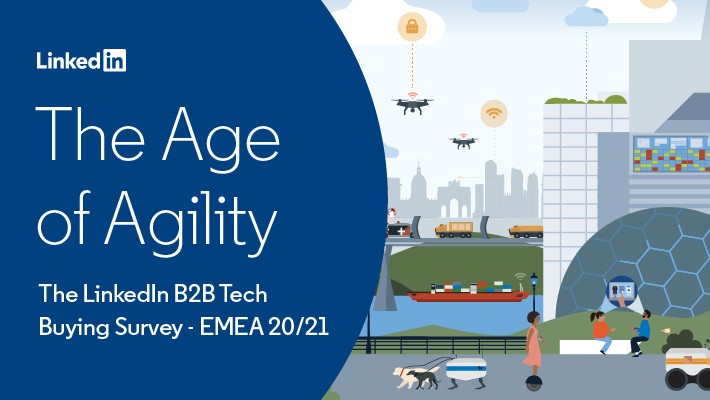Trends, tips, and best practices
Technology buying has evolved in the Age of Agility – new research for tech marketers
Digital transformation hit full speed in 2020, as organisations and individuals adapted to new ways of living and working. Trends already underway were accelerated, and new technologies came to the fore, with both early and late adopters swept along by the demands of a more virtual world. More than ever before, technology demonstrated its power to connect, drive operational efficiency and enable differentiation. But amid such rapid change, agility has become vital for survival.
For technology marketers, this new digital world offers both challenges and opportunities, as tech buyers – and how they buy - have rapidly evolved. No longer a distinct department, technology spans every area of business and every employee. So, while the need for innovative digital solutions is greater than ever, identifying and targeting the right tools to the right people has reached new levels of complexity.
To understand the trends at play and help tech marketers to navigate these new demands, LinkedIn conducted its seventh annual survey of technology buyers and decision-makers across EMEA. The LinkedIn Tech Buyer Survey is one of the largest research surveys of its kind, questioning over 2,000 tech decision-makers across the region. This year’s report paints a picture of a new and dynamic landscape, with insights on how to protect and grow your business in these unpredictable times.
Welcome to the Age of Agility.
Reassessing the fundamentals
As digital innovation becomes an even greater differentiator for businesses, technology buyers are conflicted between the need to invest in digital solutions to adapt, while also, in many cases, managing with tighter budgets. Reflecting this conflict, budgets are holding up or increasing for nearly half of organisations (43%), while on the flipside, a similar percentage (47%) report that their budget will decrease or halt altogether in the next 12 months. In this climate, the pressure is on technology providers to prove that their solutions will deliver return on investment.
Targeting a hard-to-reach buying committee
Reaching tech buyers used to be relatively straightforward - you could find them in the IT department. But as tech has become integral to everyone and everything, IT professionals are increasingly taking a back seat, with decision-making instead devolved across departments. IT is now the most influential voice in only a third (39%) of technology buying decisions, down from 75% in 2014. Meanwhile, over half of tech decision-makers (56%) now sit outside the IT department, in roles such as sales and marketing, business development, and finance.
With a growing breadth of departments involved in the process, B2B technology buyers have also become increasingly hard to target if you’re still working with niche and preset IT decision-maker (ITDM) personas. Not only are buying processes getting longer – 40% say that they now last over a year – but an extended buying committee is dipping in and out at different points in this journey. For example, over half of respondents (55%) are involved in the researching and shortlisting stages, while only a third are actually involved in purchasing (36%).
Nearly three quarters (70%) of tech buyers do their own research before even reaching out to a vendor, and only 25% of B2B buyers say that they’re willing to share contact details to access interesting content. To compete effectively, tech marketers need to start working with this new type of buying journey rather than battling against it – broadly targeting ‘anonymous buyers’ by providing them with value and information, without asking for anything in return.
What tech buyers want
Established brand or challenger? Tech buyers today are spoilt for choice, as an array of new brands challenge the reliability of incumbents. But what the research highlights is that buyers don’t want to choose between one or the other, they want both. Over three quarters of tech buyers report that deep experience and knowledge (76%) are important, while 45% saying that they would consider a new vendor if they are more innovative than the established brands. Marketers must therefore walk this messaging tightrope effectively, showing that their offering ticks all the necessary boxes.
Post-sales support: As many organisations tighten their belts, tech buyers are looking for the maximum value possible from their digital investments, and that means support that extends beyond contract signing. With tech implementation taking over five months on average for enterprise buyers, post-sales support is a key consideration for over half of respondents (56%), making it an important point of differentiation for marketers looking to hit the right note with their messaging and campaigns.
End user reviews: They might not want to speak to your company too early in the process, but buyers do want to hear from your customers about their experiences. We live in the review economy, and professional peer reviews are rated by far the biggest factor for driving ‘increased trust of product’ (56%). So, whether it’s through social media, review sites or case studies, marketers need to make their end-users true advocates for your brand, helping to develop that all important trust and reputation.
As we settle into 2021, and uncertainty rumbles on, it seems clear that life is never going to be quite the same again. But with crises come opportunities, and the huge advances made in digitisation is one of the silver linings of the last 12 months. Likewise, technology and innovation are the key to getting businesses back to their best over the next 12, and tech marketers can be at the forefront of driving that recovery. Over the coming weeks, we will be diving into actionable recommendations to succeed in the Age of Agility so we can move forward, together.
To read the full findings and analysis, The LinkedIn Technology Buyers Survey – EMEA Report 20/21 can accessed today.
Topics: Research and insights Tech marketing Trends, tips, and best practices LinkedIn Ads
Related articles


